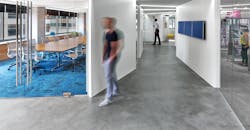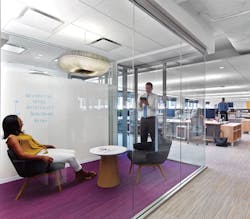The Washington, D.C.-based headquarters of the American Society of Interior Designers is the first space in the world to achieve Platinum Level Certification for both the WELL v1 Building Standard (WELL) and Leadership in Energy and Environmental Design (LEED) under the LEED ID+C rating system v3. Their new space is designed to exemplify the Workplace for the Future and serve as a living laboratory for the design community. As such, ASID prioritized green building certification as a means of realizing innovative health and wellness features as well as promoting sustainability.
Why the focus on WELL? It starts with the 3/30/300 concept. As a rule, organizations spend approximately $3 per square foot per year for energy, $30 for rent, and $300 for personnel. Since people are typically an organization’s most valuable asset, improving their overall experience delivers the greatest return on investment. Furthermore, investments that focus on wellness and sustainability are proving to have exponential results in terms of employee satisfaction and productivity. The WELL Building Standard provides a model for space design and construction that integrates performance-based systems to positively impact the built environment. Lighting and lighting control can have significant impact on all three areas of building cost, and can make essential contributions toward WELL and LEED certification.
In the ASID offices, every light is controlled, and solar-adaptive shading software silently and seamlessly adjusts the shades over the course of the day, minimizing glare, reducing heat gain, and enhancing comfort throughout the space (Photo 1). The system also provides clear visibility to building data. With the right software and graphic user interface, the facilities team can easily make adjustments and adapt system settings to ensure the space remains dynamic and responsive to occupant needs and changing space requirements — this is one example of how building systems can help save energy, simplify operations, and create the right environment over the life of the space.
Many early supporters of LEED certification are also turning their attention to the WELL standard as a guideline for design focused on wellness, comfort, and productivity. WELL Building Certification can help to address another pressing need — the ability to attract and retain top talent in an increasingly competitive environment. Beyond a simple ROI, the WELL Building Standard offers a value proposition that includes:
• Improved environment for employees and clients.
• Thought leadership.
• Increased productivity.
• Improved employee satisfaction and retention.
Using the ASID project as an example, it’s possible to delve into how specific control strategies support WELL Building Standard concepts and features necessary for certification, and help the building achieve WELL certification.
WELL certification background
Certification starts with seven concepts that influence human behaviors and define a wellness-focused environment: air, water, nourishment, light, fitness, comfort, and mind. Under these concepts, there are “Features” or provisions that have their own requirements, some of which are mandatory “preconditions” and others that are optional “optimizations.”
As outlined on the International WELL Building Institute web site, there are three levels of WELL Certification: silver, gold, and platinum. Silver level certification is achieved by meeting 100% of the WELL preconditions applicable to the project type in all concepts. Gold level certification is achieved by meeting all of the WELL preconditions as well as 40% or more of the optimization features. Platinum level certification is achieved by meeting all of the WELL preconditions as well as 80% or more of the optimization features.
The light concept area provides illumination guidelines to minimize disruption to the human body’s circadian system, enhance productivity, and provide visual acuity. The WELL Building Standard promotes lighting solutions that increase alertness, enhance the overall occupant experience, and even promote healthy sleep. In designing systems that help achieve WELL features, lighting professionals will consider standard strategy categories, including activity-based light levels, color quality, daylighting, and glare control for any given space.
For the ASID project, James Benya and Deborah Burnett of Benya Burnett Consultancy created a lighting design to ensure circadian-optimized lighting and daylighting, critical luminaire placement, and annual lighting schedules/sequences. It’s important to note that ASID was committed to achieving platinum level in both WELL and LEED certifications. Because these standards provide complementary, but different benefits, designing a lighting control system that effectively supports both certifications demands intricate knowledge of both the lighting control system capabilities and the certification requirements.
Ultimately, the integrated lighting solution contributed toward points in five WELL concept areas and helped achieve 10 of the 86 features (or 12%) required to achieve WELL Platinum. The innovative lighting design contributed to the achievement of all lighting features in the WELL Light concept with the exception of daylight fenestration. By including automated shades and the selected shade fabric, ASID was able to meet mandatory preconditions and optional optimizations in four additional WELL concept areas: air, comfort, mind, and innovation. Let’s examine some of the areas where control solutions can have the most significant influence.
Visual Lighting Design, Feature #53
This feature defines required average light levels of 215 lux on the horizontal plane, measured at 30 inches above the floor, as well as independently controlled zones of light no larger than 500 square feet. It defines the appropriate brightness and contrast ratios on different surfaces among spaces (e.g., no greater than +/-10X in main room than ancillary rooms) and among surfaces within a space (e.g., surface cannot exhibit three times greater or lesser luminance than an adjacent surface) to avoid dark spots or excessively bright spots in a room. Tunable lighting (setting maximum lighting output to the appropriate illuminance level) helps designers meet the contrast ratios.
A lighting design can meet required lux with fixtures alone, but this strategy can result in very bright light, which is acceptable earlier in the day but considerably less desirable in the late afternoon when it can negatively affect sleep patterns. Designing an integrated light management system with usable daylight enables the shades to help regulate daylight, provide the required footcandles, and prevent glare, while the drivers/ballasts automatically dim to help save energy. In addition, the lighting zones must be no larger than 500 square feet or 20% of an open office floor plan. Digitally addressable ballasts and drivers can accommodate zoning requirements without the need for complex wiring. When the furniture or layout inevitably changes, zones can be easily adjusted from a computer with no need to rewire.
Tunable white fixtures and controls allow lighting to be adjusted automatically and unobtrusively over the course of the day. For example, short wavelengths of light (the violet/blue end of the visual spectrum) can be included earlier — then scaled back in the afternoon and evening to prevent sleep disruption. While WELL certification does not focus on energy efficiency, energy savings is a consideration in most commercial buildings. Lighting control solutions that integrate with daylight and occupancy sensors, or daylight responsive shading, can play a significant part in tuning the light for the right environment, significantly reducing energy use.
Feature #54 addresses Circadian Lighting Design
This aspect of WELL certification is designed to provide lighting conditions that reinforce natural patterns of the human circadian cycle with appropriate melanopic light intensity in work areas. At least one of the following requirements must be met:
• 200 equivalent melanopic lux (EML)/18.6 fc is present at 75% or more of workstations, at 4 ft. above the finished floor, between 9 a.m. and 1 p.m. every day of the year.
• For all workstations, electric light provides maintained illuminance on the vertical plane facing forward (to simulate the view of the occupant) of 150 equivalent melanopic lux or greater.
EML is calculated by measuring the visual lux and multiplying it by a ratio that correlates to the impact the light has on the body’s sleep/wake cycle. Shorter wavelength light (blue) has a stronger biological response than longer wavelength light (yellow or red). The ratio of shorter wavelength light will be higher due to the impact on the body’s circadian system. The ratio for a 6,500K fluorescent light might be 1.02 because it has a lot of stimulating blue light while the ratio for a 2,950K fluorescent light may be 0.43 because its spectral power distribution contains lower amounts of stimulating blue light.
The Melanopic Light Intensity in Works Areas option requires at least 250 EML on the vertical plane facing forward for 75% of the workstations for at least four hours each day. If a light meter measures 275 lux, and you multiply it by the ratios listed above, that yields 280.5 EML for the 6,500K lamps — and only 118.25 EML for the 2,950K lamps. Since the Well Building Standard requires 250 EML, the 6,500K lamps meet the requirements while the 2,950K lamps do not.
The blue light that helps meet EML during the day can have a negative impact on sleep at night. This is one motivator for the enhanced use of color-tuning luminaires — they can provide the biologically active light during the day at lower power consumption, and adjust to less biologically active light in the evening and night.
Precondition Feature #56, Solar Glare Control and Optimization Feature #60
Automated Shading and Dimming Controls. Automated, solar-adaptive window shading systems work in conjunction with smart lighting control solutions to help reflect harsh, direct sunlight away from occupants while still preserving highly desirable view.
Feature #62, Daylight Modeling
Automated shades were also selected to meet daylight modeling requirements (Photo 2). Manual shades could have been used in this case, but automated shading also helps meet essential LEED Daylight credits.
The design, brought to life by lighting designers Benya and Burnett, also contributed to four additional features:
Educational outreach contributed to Feature #101: Innovation and provided data needed to support certification, and automated shades with low VOC-emitting fabric help meet the mandatory preconditions for Feature #4: VOC Reduction, Feature #74: Exterior Noise Intrusion, and Feature #88: Biophilia.
Additional results
Beyond achieving the metrics required for WELL certification, the ASID engaged in extensive pre- and post-occupancy research to understand and evaluate the impact of the sustainable workplace design on productivity and employee satisfaction. Specific to the lighting environment, work surfaces are 63% brighter, and employees report vast improvements in environmental condition satisfaction in the areas of physical comfort, light, and thermal comfort compared to their original offices.
Energy reduction, which can be directly attributed to the lighting control solution, amounts to an annual savings of $7,653.60. Compared to lighting energy use at full on, strategies including daylighting, tuning, occupancy sensors, and personal control reduced lighting energy use by more than 78%. A comprehensive analysis is available at ASID.org.
Jouaneh is the manager — sustainability and energy standards for Lutron Electronics Co., Inc., in Cooperburg, Pa. He can be reached at [email protected].
About the Author

Michael Jouaneh
Manager — Sustainability and Energy Standards
Michael Jouaneh is the manager of sustainability and energy standards for Lutron. He chairs the commercial Power, Lighting, and Renewables subcommittee for the 2024 International Energy Conservation Code (IECC). He is a vice chair of the ASHRAE 189.1 Standard for High-Performance Green Buildings committee. He is on the board of Green Building United and is active with many standards-development organizations, including the California Energy Commission, National Electrical Manufacturers Association, and Illuminating Engineering Society.


